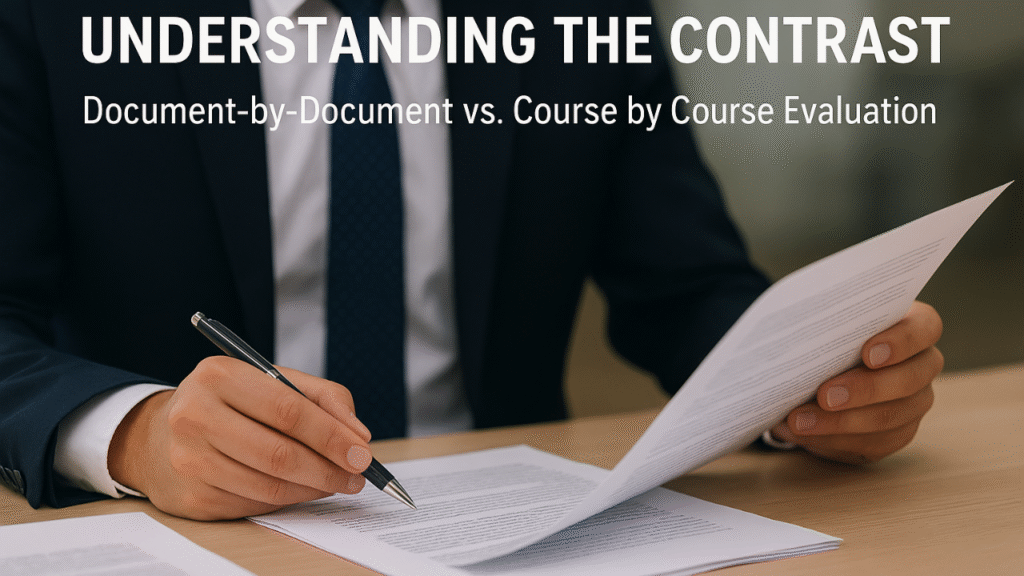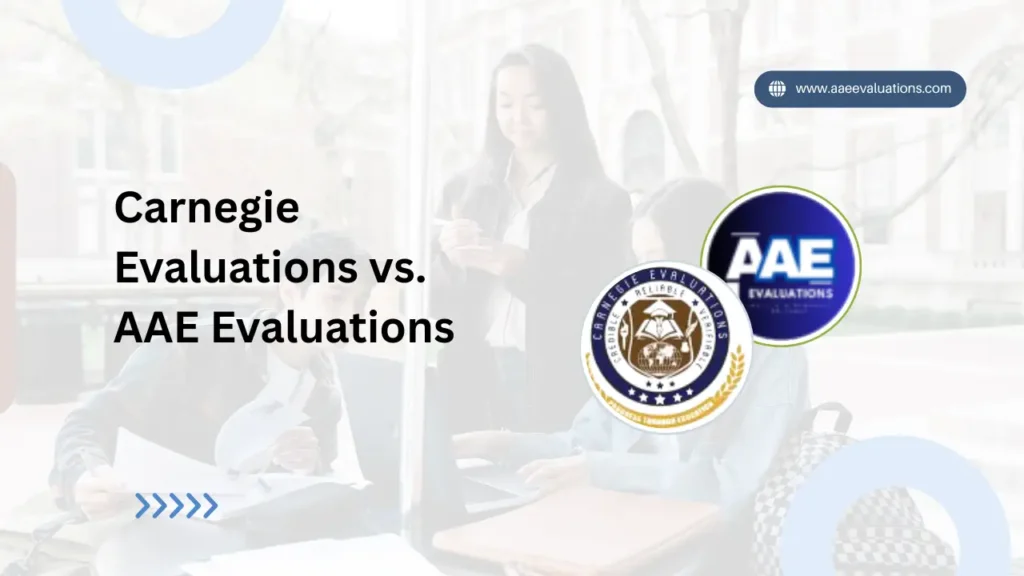Understanding Course by Course Evaluation Clearly
International education opens doors to academic, professional, and migration opportunities across the world. However, when students or professionals move from one country to another, their academic records must be clearly understood and recognized in the new region. Because education systems vary widely in grading, credit structure, and curriculum depth, a proper evaluation process becomes necessary. This is where Course by Course Evaluation plays an important role; it helps translate each subject, credit, and grade into an equivalent format accepted by universities, licensing boards, and employers, ensuring accurate academic recognition.
This is where academic evaluation services play a crucial role. Two of the most widely used evaluation formats are Document-by-Document Evaluation and Course by Course Evaluation. While both are used to analyze academic qualification, each serves a different purpose and is used in different application scenarios.
The goal of this blog is to provide a comprehensive, in-depth, and easy-to-understand comparison of these two formats. More importantly, this guide will help you determine when you must choose Course by Course Evaluation (Primary Keyword), especially if you are applying to schools, transferring credits, or pursuing a professional license.
Why Credential Evaluation is Necessary
Each country follows its own:
- Grading system (percentage, grade points, division, letter grades, etc.)
- Degree duration (2-, 3-, or 4-year undergraduate programs)
- Credit/semester structures
- Curriculum and subject depth
- Accreditation and institutional recognition standards
Because of these differences:
- A Bachelor’s degree in one country may not automatically match the level of a Bachelor’s degree in another.
- The number of credits completed may not align.
- Course content and equivalence may vary.
Credential evaluation helps institutions and employers understand the academic qualifications clearly and accurately. It ensures your education is represented fairly in the new academic or professional setting.
What is Document-by-Document Evaluation?
Document-by-Document Evaluation provides a general overview of your educational qualification. It verifies your academic documents and identifies the level of degree earned compared to the target country’s educational framework.
Key Features of Document-by-Document Evaluation:
- Verification of the authenticity of academic records
- Listing of institutions attended
- Identification of degree level (e.g., U.S. Bachelor’s equivalent)
- Overview of dates and location of study
What It Does Not Include:
- No subject-by-subject breakdown
- No GPA calculation
- No credit hours conversion
This evaluation summarizes your educational background at the qualification level, not the coursework level.
When is it Used?
| Purpose | Why This Format Works |
| Employment | Employers may only need proof of your degree level |
| Immigration petitions | Agencies require degree equivalence, not coursework |
| Resume enhancement | Helps clarify your education in international job markets |
| Government applications | Basic verification is usually sufficient |
This format is often faster and more affordable due to its simplicity.
What is Course by Course Evaluation?
Course by Course Evaluation is a detailed analysis of your academic work. Instead of looking only at the degree, this evaluation reviews every course/subject taken, the grades earned, and the total academic hours completed. It converts these into the educational structure of the United States.
What Course by Course Evaluation Includes:
- A full list of courses completed
- Conversion of grades into U.S. 4.0 GPA scale
- Conversion of credit hours into U.S. semester credit equivalents
- Calculation of overall cumulative GPA
- Degree equivalency statement
- Verification of institutional recognition
This evaluation is more precise because it focuses on academic content, not just the degree itself.
Why is Course by Course Evaluation USA Often Required?
When applying to universities or licensing boards, decision-makers need to know:
- What subjects you studied
- Whether your coursework matches U.S. standards
- Whether your credits can transfer
- How your academic performance compares in the U.S. scale
Therefore, Course by Course Evaluation USA is typically mandatory for:
- College & university admissions
- Transfer credit assessments
- Teacher, engineering, medical, accounting, or legal license applications
- Graduate program eligibility review
- Scholarship and financial aid evaluation
Professional Comparison Table
| Feature | Document-by-Document Evaluation | Course by Course Evaluation |
| Detail Level | Basic | Highly detailed |
| Lists Courses Individually | No | Yes |
| Converts Grades to U.S. Scale | No | Yes |
| Converts Credits to U.S. Semester Credits | No | Yes |
| Calculates GPA | No | Yes |
| Needed For | Immigration, employment, general verification | University admission, credit transfer, licensing |
| Cost | Usually lower | Usually higher (due to detailed analysis) |
| Processing Time | Faster | Longer |
When Should You Choose Course by Course Evaluation?
You should choose Course by Course Evaluation if:
- You are applying to university or college programs
- You need your credits transferred to continue your education
- You are applying for professional licensure in fields such as engineering, nursing, accounting, or teaching
- You want your GPA calculated in U.S. standards
- You require recognition of subject-specific learning
Examples:
| Scenario | Why Course by Course Evaluation is Required |
| You studied engineering abroad and want to work as a licensed professional engineer in the U.S. | Licensing boards require proof of subject-level competencies |
| You completed a Bachelor’s degree overseas and want to apply for a Master’s degree in the U.S. | Universities compare course structures before offering admission |
| You want to continue from 2nd or 3rd year in a U.S. college | Schools need to determine credit transfer equivalency |
Understanding Course to Course Evaluation
The term Course to Course Evaluation is often interchangeable with Course by Course Evaluation. Both refer to the detailed subject-based analysis. The purpose is to determine how each completed course compares to the educational framework in the destination system.
This ensures clarity when:
- Matching subjects for transfer credit
- Reviewing professional eligibility
- Identifying curriculum gaps for licensure programs
Why Accuracy Matters in Course by Course Evaluation
If evaluation is done incorrectly, the consequences can be significant:
- Loss of academic credits
- Reduced admission eligibility
- Repeating subjects already mastered
- Licensing rejection
- Scholarship disqualification
Because of this, choosing a recognized evaluation provider such as AAE Evaluation is essential. Accurate evaluation protects your academic and career ambitions.
How Course by Course Evaluation is Completed (Step-by-Step)
- Document Submission
- Degrees, transcripts, mark sheets, certificates
- Institution Verification
- Confirming that your institution is accredited and recognized
- Course Content and Hours Review
- Classroom hours and academic load examined
- Grade Conversion
- Grades translated to U.S. GPA scale for transparency
- Credit Conversion
- Credits converted to U.S. semester credit system
- Final Report Preparation
- Detailed, standardized evaluation report is issued
This report becomes your academic identity in your new academic or professional path.
Practical Example Case Study
Case:
An international student completed a 3-year Bachelor’s degree abroad and wants to apply for a U.S. Master’s program.
- Document-by-Document evaluation may classify the degree as equivalent to a U.S. Bachelor’s degree.
- But the university still needs:
- GPA
- Course list
- Credit hours
Therefore, Course by Course Evaluation is required to assess eligibility.
Benefits of Course by Course Evaluation
| Benefit | Result |
| Subject-level clarity | Helps admission and licensing committees make informed decisions |
| GPA Conversion | Supports scholarship and merit-based selection |
| Credit transfer eligibility | Saves tuition, time, and coursework repetition |
| Consistency with U.S. standards | Enhances admission and professional acceptance |
| Supports long-term academic mobility | Works across institutions and state-level licensing bodies |
Frequently Asked Questions (FAQ)
Q1. How long does Course by Course Evaluation take?
Processing times vary depending on document volume and verification needs. Detailed evaluation naturally takes longer than basic formats.
Q2. Can the evaluation be used for multiple applications?
Yes, but some universities require electronic delivery directly from the evaluator.
Q3. Does Course by Course Evaluation guarantee credit transfer?
No. Universities decide on credit transfer. The evaluation provides equivalency; the institution makes the final decision.
Q4. Can I apply for scholarships using the GPA in this evaluation?
Yes. Many scholarship committees rely on standardized GPA comparisons.
Choosing a Trusted Academic Evaluator
Selecting the right evaluation service is important because accuracy directly affects academic and professional outcomes. AAE Evaluation provides reliable and structured academic evaluation services that convert international credentials to U.S. equivalents with transparency and accuracy.
Final Thoughts
Both Document-by-Document and Course by Course Evaluation formats are important, but they serve different purposes. Document-by-Document gives an overview of educational level, suitable for employment or immigration. However, when applying for higher education, transferring credits, applying for scholarships, or pursuing professional licensing, Course by Course Evaluation becomes essential.
Understanding which evaluation format to choose ensures smoother applications, clearer recognition of academic achievements, and fewer delays.
If your goal involves studying or getting licensed in the United States, Course by Course Evaluation is the recommended path.



